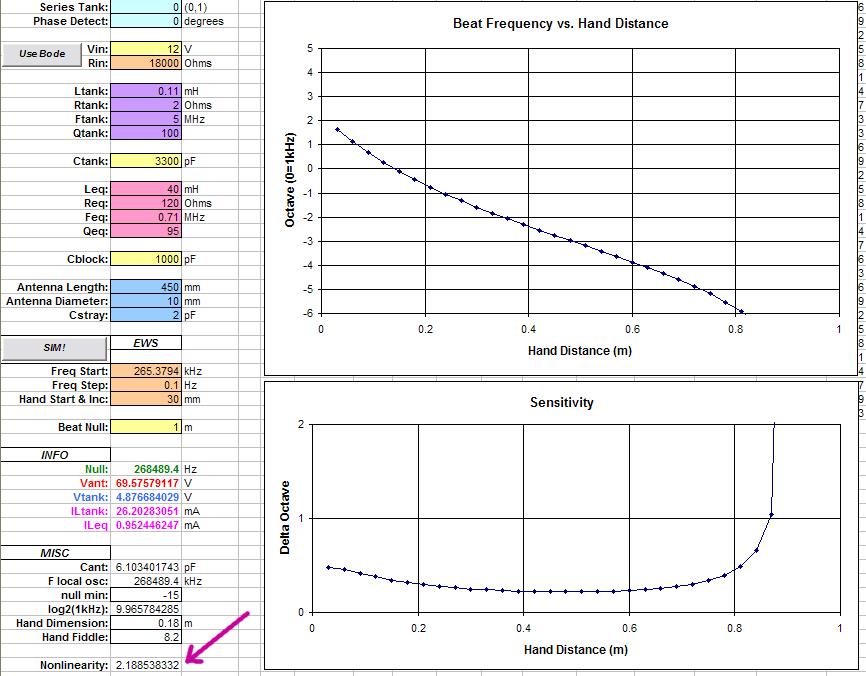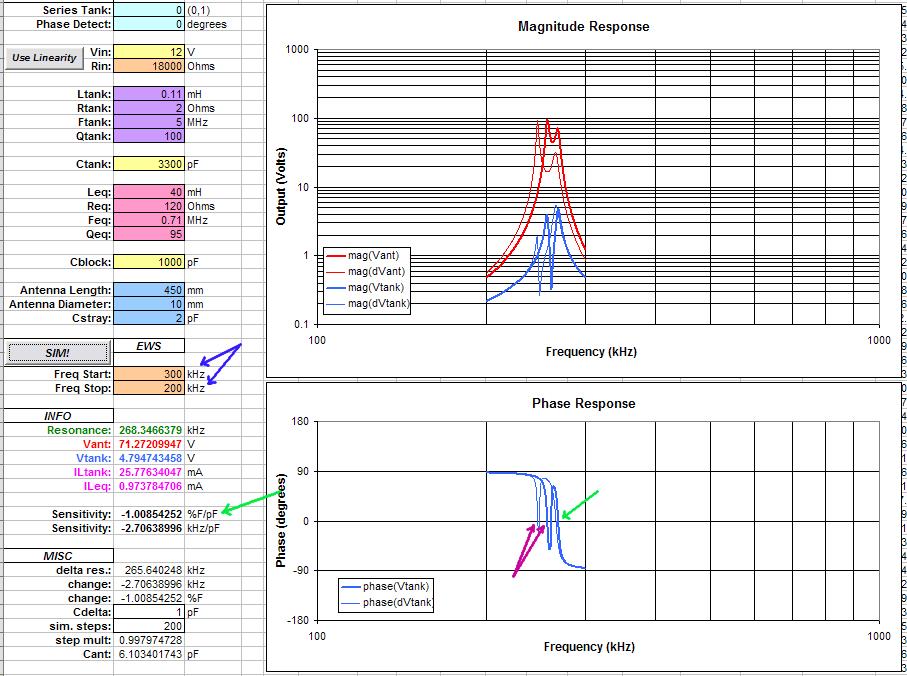"Anyway, I can't quantitatively check simulation linearity without proper resonance detection, and the above is something of a can of worms." - Dewster
Just a quick interjection here (Moving out is taking longer than anticipated - damn estate agents just keep dragging the process and demanding more non-returnable fees to do meaningless credit checks etc)..
I dont know about the EW (although I see no reason why this shouldnt work with the EW) but I have used a method to crudely determine resonance, which you may find useful..
I have a seperate big (>= 10uF) and parallel low ESR/ESL decoupling/filtering/smoothing capacitor across the supply to my variable oscillators, and an accessible link upstream (I use a 0.1" "handbag") to connect the supply to the oscillator.
By replacing the link with a low Z mA meter, I can monitor current drawn by the oscillator - As the majority of this current is determined by the antenna current, and as this current is primarily determined by proximity to resonanace, this has been a useful tuning and diagnostic aid.
The advantage of this scheme over others, IMO, is that one gets a change in DC current (integrated by the supply capacitors) and there is nothing in the HF antenna path to distort or change the resonant frequency etc.
I have actually used the above scheme in some designs to facilitate linearization, by providing a seperate control voltage derived from this current as frequency control feedback.
Fred.
ps.. @Thierry .. I think the "art" comes down to the playability and quality of the tone. I do not believe that it has anything to do with how fiddly or difficult the instrument is to set up.
With electronic musical instruments, the playability comes down to (1) the quality of the player / instrument interface IMO.. Simple example - the quality of the keyboard has a HUGE effect on playability - the same instrument equipped with a good weighted keyboard is hugely superior to one fitted with a crappy plastic keyboard.. (2) the quality of the tone, regardless of how this is produced.
I therefore do not agree with
"The idea of almost zero factory tuning kills totally the artisanal aspect of traditional music instrument building."
I would however agree that having loads of internal presets or whatever to adjust will make the likelyhood of producing nearly identical instruments far lower, and therefore each instrument is more likely to be "unique" ... But is this a good thing? Also, is "traditional" really a word that can be used with any "merit" when it comes to electronic musical instruments?.. "Tradition" spans many generations, there is no person alive today who witnessed creation of the first (original) violin, or even a great grandchild alive today of anyone who witnessed this (in fact, I think the 'original' violin probably goes back more than 1000 years)
- but we have musicians alive today who met (and were taught by) the inventor of the theremin, and nothing like it existed 100 years ago! IMO, we cannot talk about "traditional" electronic musical instruments - not until a few hundred years more have elapsed!
I do not believe that "luthier" or even perhaps "artisan" are really the correct words for creators of electronic musical instruments - oh, I agree that they are nice words, and create an aura of something special - but I do not really think they are justified or accurate - not even for Lev or Bob! - I think the better word would be pioneers.. They (and us) are just at the start, these instruments will evolve (and some perhaps go extinct as is the way of natural selection) - perhaps this is what makes it exciting, and why perhaps a disproportionate number of engineers,inventors,developers and "explorers" are drawn to this field...
IMO, we are not traditionalists, we are innovators and pioneers.. Traditionalists work on creating and refining traditional acoustic instruments using traditional methods and not introducing massive changes or innovations, because these have, well, a tradition! The electric guitar is, IMO, an example of a "traditional" instrument where the applied innovation moved the instrument outside the remit of "tradition" - too much innovation and change, and one moves into a murky realm on the fringe of tradition - IMO, No such "problem" exists with purely electronic instruments - they are new, and have no ties to tradition - even if they try to have (Theremin Cello, for example).
IMO, if one has a load of adjustable controls, these should be accessible to the player, so that they can be adjusted to the players preference - and they should not be critical - as in, the instrument should always be playable regardless of how these controls are set.. Or, at least, adjustment should never endanger the functioning of the instrument - so if one did adjust such that the instrument ceased to play, it could easily be brought back to operation. I do not see any point in making the instruments more difficult or costly to manufacture or calibrate than is absolutely essential, or that designing for minimum (or zero) manual adjustment at manufacture in any way "kills" anything!
I think this was one of Bob Moog's great insights - He produced instruments which gave musicians huge control over the sounds and interface / control.. In the main, his instruments did not impose "presets" with his or someone elses idea of a sound or even mode of operation - He let the musician be the "artisan".. I believe that he made a big mistake when he failed to extend this principle to the theremin, where things like the volume response curve was invariable, and control of tone was limited.
Bob's designs (and analogue electronic musical instruments in general) have required a lot of manual adjustment at manufacture, but this is being reduced in recent designs - with analogue, one is often forced to trim circuits, but this is not by choice - and 'new' programmable resistors and potentiometers (and other mixed signal components) are making automated calibration easier to implement, with huge beneficial results.



